Setting Up SteelHead-v on ESX/ESXi
VMware ESX and VMware ESXi are hypervisors that enable you to install and run the SteelHead as a virtual appliance. For details about VMware ESX and ESXi, go to
http://www.vmware.com.
Your hardware must be compatible with VMware ESX or ESXi to deploy SteelHead-v. To ensure hardware compatibility, go to
http://www.vmware.com/resources/compatibility/search.php.
SteelHead-v supports ESX/ESXi 4.0 and later. If you use the NIC card, you must use ESXi 4.1 or later. For ESXi 5.0 and later, the method for supporting the card differs from the 4.1 method. For information, see
Completing the Preconfiguration Checklist.
Note: For detailed information about ESX/ESXi or any other VMware products, see the VMware documentation.
This chapter describes how to install and configure SteelHead-v on VMware ESX and ESXi. It includes the following sections:
Basic Steps for Installing SteelHead-v on ESX/ESXi
This section provides an overview of the basic steps to install and configure SteelHead-v on ESX and ESXi. Detailed procedures are provided in the sections that follow.
If you are installing on a Cisco SRE, see the section
SteelHead-v Deployment Guidelines. If you have installed a Riverbed NIC, see the section
Completing the Preconfiguration Checklist. Task | Reference |
1. Confirm that ESX/ESXi is provisioned to run the SteelHead-v model. Check to make sure the resources are available, and configure ESX/ESXi before choosing your SteelHead-v model. | |
2. Obtain the SteelHead-v package from Riverbed Support. | |
3. Gather network settings for the configuration wizard. | |
4. Deploy the SteelHead-v image, which automatically configures the SteelHead-v to the VCX255U model specifications. | |
5. In VMware vSphere Client or Open Virtual Machine Format (OVF) Tool, configure the VM to accommodate the correct target SteelHead-v model specifications. You can skip this step if you are installing a model VCX255U and have the appropriate hardware. | |
6. Power on the VM, start the SteelHead-v, and log in. | |
Obtaining the SteelHead-v Software Package
SteelHead-v is provided by Riverbed as a software image that contains the VMX and VMDK files necessary to create the VM.
The SteelHead-v image is an installable OVA package. OVA is a platform-independent, efficient, extensible, and open packaging distribution format. The OVA package provides the complete default specification for SteelHead-v, including its required virtual disks, CPU, memory, networking, and storage. To install a SteelHead-v model other than the default model, you first install the default and then upgrade it to a higher model.
The default model for the xx55 VCX models is a VCX255U.
The OVA is a compressed .tar.gz package that quickly creates a VM with predefined settings. It contains the following files:
• OVF file - Provides the XML description of SteelHead-v.
• Two VMDK files - One file contains the management system (the smaller VMDK) and the other contains the data store. The separate files let you resize the RiOS data store without losing any data in the management partitions.
• Manifest file - Contains the SHA1 checksum of the OVF and VMDK.
• VMX file - Contains the primary configuration.
You can download the OVA package from the Riverbed Support website at https://support.riverbed.com. Access to the software downloads requires registration.
Installing SteelHead-v with a Riverbed NIC
In RiOS 8.0.3 and later, you can configure bypass support using the VMware Direct Path feature on ESXi 5.0 and later virtual hosts. This feature allows SteelHead-v to directly control the physical bypass card. The procedure for configuring bypass support for ESXi 5.0 and later is documented in the Network and Storage Card Installation Guide.
For instructions on how to configure bypass support on prior releases of ESX/ESXi, see
Configuring a Riverbed NIC in ESX 4.1In RiOS 8.6 and later, some SteelHead-v models support a 2-port 10-GbE Multimode Fiber NIC (direct I/O only).
Note: You must use a Riverbed-branded NIC. SteelHead-v supports only Riverbed-issued NIC cards. If you currently use a Riverbed-branded NIC with ESXi 4.1, you can use the same card if you want to upgrade the ESXi version. However, you must reconfigure the card to support the bypass method used in ESXi 5.0.
Note: Using pass-through devices requires that a memory reservation be made for the full amount of allocated memory. This reservation is done automatically initially, but if a model upgrade requires more memory, you must manually increase the reservation before powering on the VM.
Completing the Preconfiguration Checklist
This section lists the parameters you specify to complete the initial configuration of SteelHead-v.
Be prepared to provide values for the network settings listed in the following checklist when prompted by the configuration wizard.
Network Setting | Your Value |
Hostname | |
IP address | |
Netmask | |
Default gateway | |
DNS Server | |
Domain Name | |
Installing SteelHead-v
This section describes the procedures for installing the VM OVA package obtained from Riverbed. You install the package using your VMware management tools, either OVF Tool or VMware vSphere Client. This section describes how to install and configure the default SteelHead-v model on a VMware ESX host using the vSphere Client.
The default model for the xx55 VCX models is a VCX255U.
To install a SteelHead-v model other than the default model, install the default and upgrade it to a higher model.
The installation package contains predefined hardware requirements and configuration for the default model SteelHead-v. Do not open or modify any of the files in the package. The package files use several gigabytes of disk space (the package itself is less than 1 GB).
Note: See the VMware website for documentation on OVF Tool and vSphere Client.
To install SteelHead-v
1. Obtain the VM package from https://support.riverbed.com and download it locally.
2. Open VMware vSphere, enter the IP address or name, enter your username and password, and click Login.
Figure: vSphere Client Login Page

3. Choose File > Deploy OVF template.
4. Select Deploy from file, click Browse, select the OVA file, and click Open.
Figure: Deploy OVF Template Page
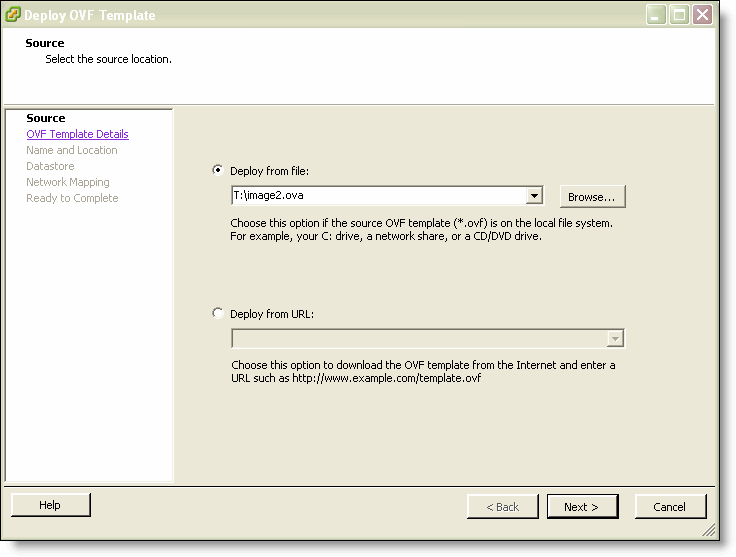
5. Click Next.
Figure: Deploy OVF Template Details Page
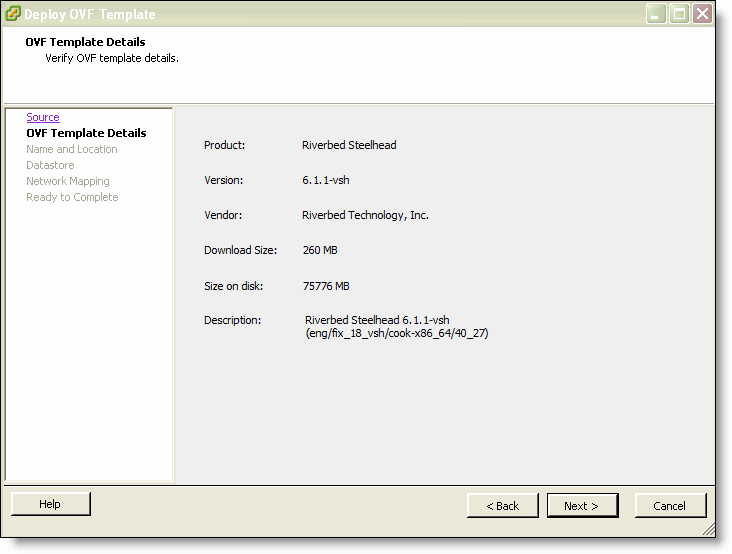
6. Verify that the OVA file is the one you want to deploy, and click Next.
Figure: Name and Location Page
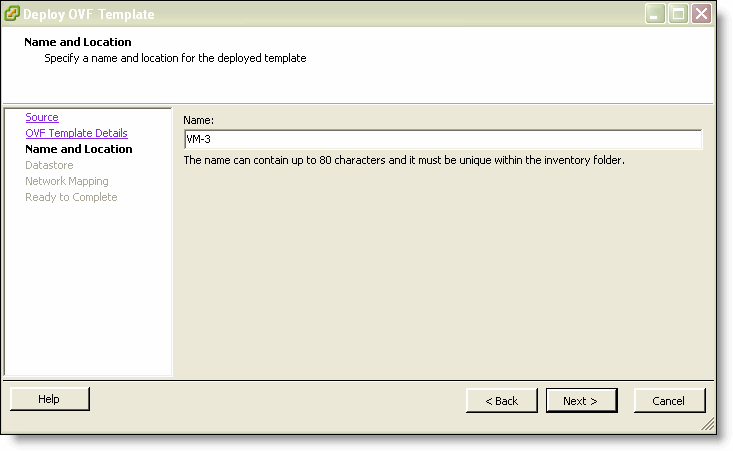
7. Specify a name for the VM.
8. Click Next.
Figure: VMware Datastore Page
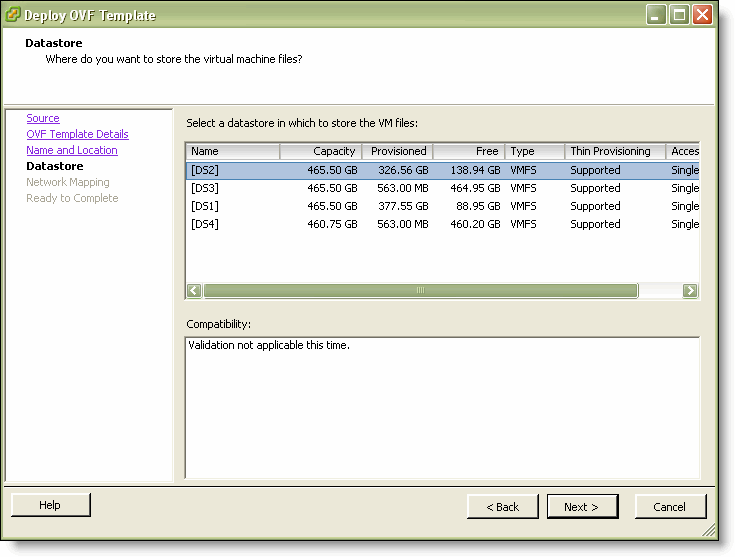
9. Select a host datastore in which to store the VM and its virtual disk files:
• The standard installation puts both VMDKs on a single host datastore. The datastore that holds the VMDKs can be modified later in the install process.
• Make sure that the host datastore you select has enough capacity for the OVA package to install. For example, for a VCX255U you need at least 88 GB. For a VCX555M you need at least 130 GB.
• You can install the smaller VMDK containing the management disk on a datastore backed by any type of underlying storage media.
• Riverbed recommends that you put the larger VMDK containing the RiOS data store on a host datastore backed by the fastest available storage media. That datastore should have enough room to expand to the required size of the SteelHead-v model.
• Do not share host physical disks (such as SCSI or SATA disks) between VMs. Select an unshared disk for the data store disk.
• Never delete the first VMDK, which contains the VM’s operating system.
10. Click Next.
11. On the Disk Format page, select Thick provisioned format.
Thick provisioning preallocates all storage.
12. Click Next.
Figure: Network Mapping Page
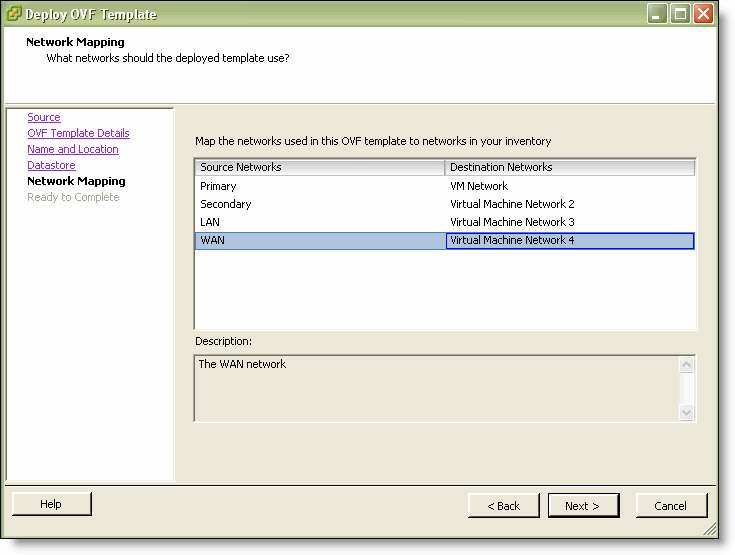
13. Select the destination network name and select a network from the drop-down list to map the source network to a destination network.
If you have installed a Riverbed NIC, you must map the LAN source network to the pg-vmnic3 port label and the WAN source network to the pg-vmnic2 port label.
Note: Make sure that you map each source network to a unique destination network. If a source network is mapped to the same destination as another source, an error message appears. Mapping source networks to the same destination network can create a loop in the system and might make your ESX host unreachable. For details, see
SteelHead-v Deployment Guidelines.
14. Click Next.
Figure: Ready to Complete Page

15. Verify the deployment settings and click Finish.
A dialog box shows the amount of time remaining for the deployment.
When the deployment finishes, a dialog box informs you that the deployment was successful.
16. Click Close.
The new VM appears under the hostname or host IP address to the VM inventory.
To set the adapter type for deployments with Riverbed NICs
Note: For ESXi 5.0 and later, see the Network and Storage Card Installation Guide.
1. In vSphere, select the ESX or ESXi host.
2. Under the host, right-click the SteelHead-v guest and choose Edit Settings.
3. Click Add.
4. Select Ethernet adapter and click Next.
5. From the Adapter Type drop-down list, select VMXNET3.
6. From the Network label drop-down list, select pg-vmnic1.
7. Click Next.
8. Click Finish.
9. Repeat the steps above, specifying network label pg-vmnic0 instead of pg-vnic-1.
10. Repeat the steps in this procedure, specifying network label pg-bpvm0 instead of pg-vnic-1.
11. Verify that the connected state of each of the four network adapters in the SteelHead-v guest are set to Connect at power on.
To confirm this setting, choose Edit Settings > Hardware and select your adapter.
12. Under the host, select Edit Settings.
Figure: Edit Settings
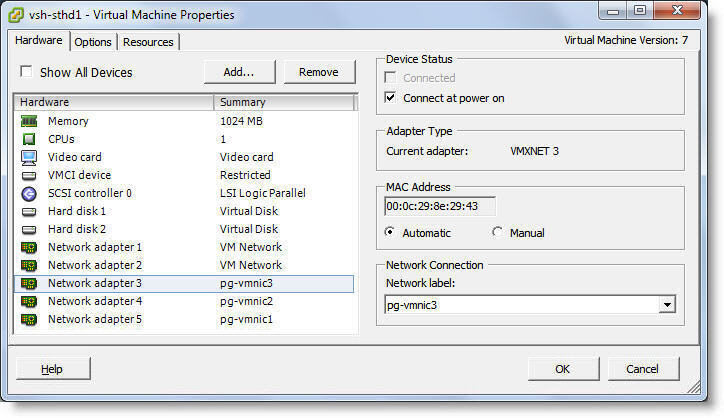
13. Click OK.
Next, you need to accept promiscuous mode on each in-path virtual NIC. Promiscuous mode allows the LAN/WAN Virtual NICs to intercept traffic not destined for the VM and is mandatory for traffic optimization for in-path deployments. If you are deploying SteelHead-v out-of-path or virtual in-path, skip this procedure and go to the section
To power on the VM.
To set Promiscuous Mode for in-path deployments
1. Open the vSphere client.
2. In the left panel, select the hostname or IP address.
3. Select the Configuration tab.
4. In the Hardware section, select Networking.
A list of virtual switches appears.
Figure: Configuration Tab
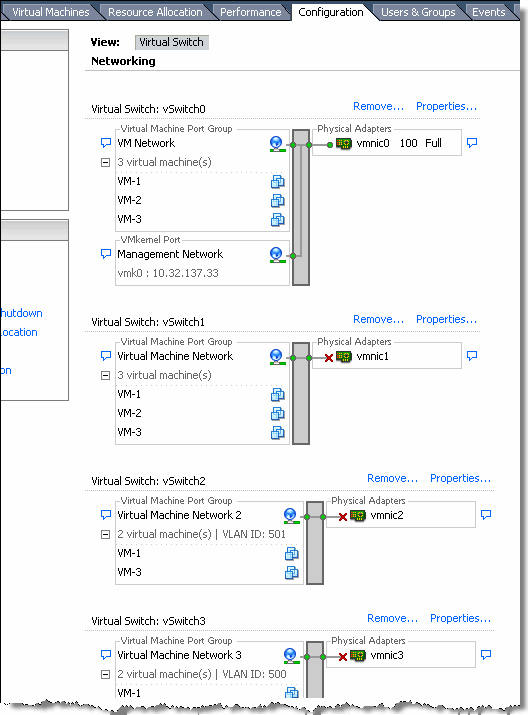
5. To the right of the first virtual switch on the tab, select Properties.
A vSwitch Properties dialog box appears.
Figure: vSwitch Properties

6. From the Configuration list, select the vSwitch configuration and click Edit.
7. Select the Security tab.
Figure: vSwitch Properties Security Tab
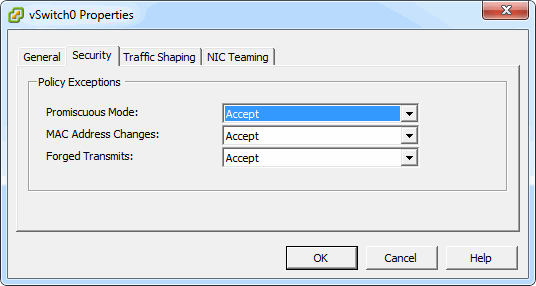
8. In the Promiscuous Mode list, select Accept and click OK.
You return to the Properties dialog box.
9. From the Configuration list, select the Port Group configuration and click Edit.
10. Select the Security tab for the port group.
11. In the Promiscuous Mode list, select Accept and click OK.
The screen returns to the Properties dialog box.
12. Repeat Steps 5 through 11 for each in-path virtual NIC.
To power on the VM
1. Right-click the VM you created, choose Power and choose Power On.
2. Select the Console tab.
3. Click the dark screen.
SteelHead-v starts up, and the login prompt appears.
Figure: Log In to SteelHead-v
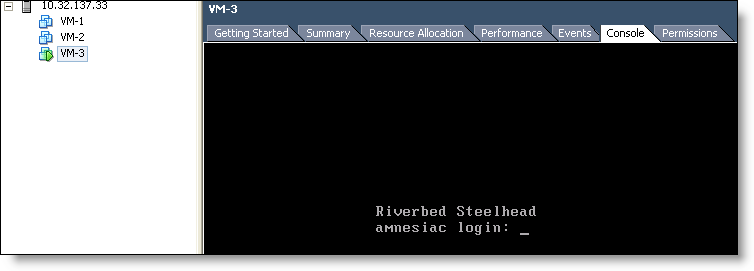
Tip: To release the cursor from the console, press Ctrl+Alt.
4. Log in to SteelHead-v as an administrator.
The default administrator login is admin and the default password is password.
For information about completing the SteelHead-v configuration see
Configuring SteelHead-v. Note: To monitor SteelHead-v resource use, you can configure alarms in vCenter. For example, you can configure an alarm when a VM experiences an unusually long wait time for CPU or other resources. For more information, see vCenter documentation from VMware.













